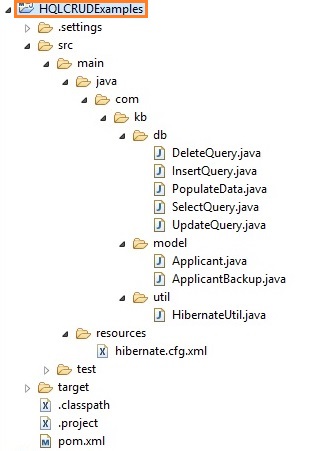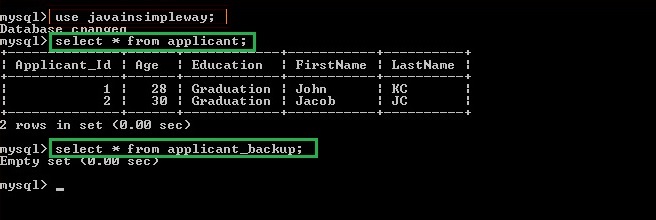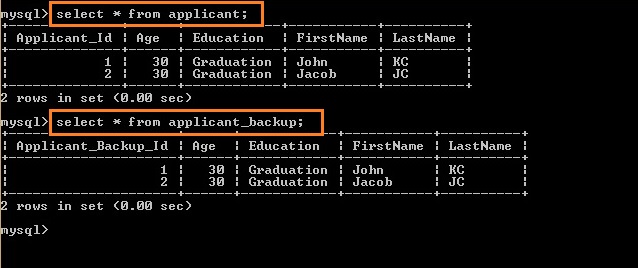HQL Insert,Update,Select and Delete Examples
- 25th Feb 2017
- 0
- 37791
- Delete query example in HQL in hibernate How Delete query works in Hibernate query language(HQL) How Insert query works in Hibernate query language(HQL) How select query works in Hibernate query language(HQL) how to to Insert in HQL How Update query works in Hibernate query language(HQL) Insert query example in HQL in hibernate Select query example in HQL in hibernate Update query example in HQL in hibernate
Let us understand how to perform Insert,Update,Select and Delete operations in HQL
Example:
In this article,we will use Applicant and Applicant_Backup tables to perform all the above operations.
Applicant_Backup table will be used to store backup data from Applicant table using HQL Insert query.
Step 1
Create hibernate project
Please refer Hibernate setup in eclipse article on how to do it.
Project structure

Step 2
Update pom.xml with Hibernate and Mysql dependencies
- <project xmlns="http://maven.apache.org/POM/4.0.0" xmlns:xsi="http://www.w3.org/2001/XMLSchema-instance"
- xsi:schemaLocation="http://maven.apache.org/POM/4.0.0 http://maven.apache.org/xsd/maven-4.0.0.xsd">
- <modelVersion>4.0.0</modelVersion>
- <groupId>HQLCRUDExamples</groupId>
- <artifactId>HQLCRUDExamples</artifactId>
- <version>0.0.1-SNAPSHOT</version>
- <packaging>jar</packaging>
- <name>HQLCRUDExamples</name>
- <url>http://maven.apache.org</url>
- <properties>
- <project.build.sourceEncoding>UTF-8</project.build.sourceEncoding>
- </properties>
- <dependencies>
- <dependency>
- <groupId>junit</groupId>
- <artifactId>junit</artifactId>
- <version>3.8.1</version>
- <scope>test</scope>
- </dependency>
- <!-- https://mvnrepository.com/artifact/org.hibernate/hibernate-core -->
- <dependency>
- <groupId>org.hibernate</groupId>
- <artifactId>hibernate-core</artifactId>
- <version>5.2.6.Final</version>
- </dependency>
- <!-- https://mvnrepository.com/artifact/mysql/mysql-connector-java -->
- <dependency>
- <groupId>mysql</groupId>
- <artifactId>mysql-connector-java</artifactId>
- <version>6.0.5</version>
- </dependency>
- </dependencies>
- </project>
<project xmlns="http://maven.apache.org/POM/4.0.0" xmlns:xsi="http://www.w3.org/2001/XMLSchema-instance"
xsi:schemaLocation="http://maven.apache.org/POM/4.0.0 http://maven.apache.org/xsd/maven-4.0.0.xsd">
<modelVersion>4.0.0</modelVersion>
<groupId>HQLCRUDExamples</groupId>
<artifactId>HQLCRUDExamples</artifactId>
<version>0.0.1-SNAPSHOT</version>
<packaging>jar</packaging>
<name>HQLCRUDExamples</name>
<url>http://maven.apache.org</url>
<properties>
<project.build.sourceEncoding>UTF-8</project.build.sourceEncoding>
</properties>
<dependencies>
<dependency>
<groupId>junit</groupId>
<artifactId>junit</artifactId>
<version>3.8.1</version>
<scope>test</scope>
</dependency>
<!-- https://mvnrepository.com/artifact/org.hibernate/hibernate-core -->
<dependency>
<groupId>org.hibernate</groupId>
<artifactId>hibernate-core</artifactId>
<version>5.2.6.Final</version>
</dependency>
<!-- https://mvnrepository.com/artifact/mysql/mysql-connector-java -->
<dependency>
<groupId>mysql</groupId>
<artifactId>mysql-connector-java</artifactId>
<version>6.0.5</version>
</dependency>
</dependencies>
</project>
We have added maven dependencies for Hibernate and MYSQL in this pom file.
Step 3
Create Applicant class
- package com.kb.model;
- import javax.persistence.Column;
- import javax.persistence.Entity;
- import javax.persistence.GeneratedValue;
- import javax.persistence.GenerationType;
- import javax.persistence.Id;
- import javax.persistence.Table;
- @Entity
- @Table(name="Applicant")
- public class Applicant {
- @Id
- @GeneratedValue(strategy = GenerationType.SEQUENCE)
- @Column(name = "Applicant_Id")
- private int applicantId;
- @Column(name = "FirstName")
- private String firstName;
- @Column(name = "LastName")
- private String lastName;
- @Column(name = "Age")
- private int age;
- @Column(name = "Education")
- private String education;
- public int getApplicantId() {
- return applicantId;
- }
- public void setApplicantId(int applicantId) {
- this.applicantId = applicantId;
- }
- public String getFirstName() {
- return firstName;
- }
- public void setFirstName(String firstName) {
- this.firstName = firstName;
- }
- public String getLastName() {
- return lastName;
- }
- public void setLastName(String lastName) {
- this.lastName = lastName;
- }
- public int getAge() {
- return age;
- }
- public void setAge(int age) {
- this.age = age;
- }
- public String getEducation() {
- return education;
- }
- public void setEducation(String education) {
- this.education = education;
- }
- }
package com.kb.model;
import javax.persistence.Column;
import javax.persistence.Entity;
import javax.persistence.GeneratedValue;
import javax.persistence.GenerationType;
import javax.persistence.Id;
import javax.persistence.Table;
@Entity
@Table(name="Applicant")
public class Applicant {
@Id
@GeneratedValue(strategy = GenerationType.SEQUENCE)
@Column(name = "Applicant_Id")
private int applicantId;
@Column(name = "FirstName")
private String firstName;
@Column(name = "LastName")
private String lastName;
@Column(name = "Age")
private int age;
@Column(name = "Education")
private String education;
public int getApplicantId() {
return applicantId;
}
public void setApplicantId(int applicantId) {
this.applicantId = applicantId;
}
public String getFirstName() {
return firstName;
}
public void setFirstName(String firstName) {
this.firstName = firstName;
}
public String getLastName() {
return lastName;
}
public void setLastName(String lastName) {
this.lastName = lastName;
}
public int getAge() {
return age;
}
public void setAge(int age) {
this.age = age;
}
public String getEducation() {
return education;
}
public void setEducation(String education) {
this.education = education;
}
}
We have specified Primary key as applicantId and generator class as “sequence” for automatic primary key generation.
Step 4
Create ApplicantBackup class
- package com.kb.model;
- import javax.persistence.Column;
- import javax.persistence.Entity;
- import javax.persistence.GeneratedValue;
- import javax.persistence.GenerationType;
- import javax.persistence.Id;
- import javax.persistence.Table;
- @Entity
- @Table(name="Applicant_Backup")
- public class ApplicantBackup {
- @Id
- @GeneratedValue(strategy = GenerationType.SEQUENCE)
- @Column(name = "Applicant_Backup_Id")
- private int applicantId;
- @Column(name = "FirstName")
- private String firstName;
- @Column(name = "LastName")
- private String lastName;
- @Column(name = "Age")
- private int age;
- @Column(name = "Education")
- private String education;
- public int getApplicantId() {
- return applicantId;
- }
- public void setApplicantId(int applicantId) {
- this.applicantId = applicantId;
- }
- public String getFirstName() {
- return firstName;
- }
- public void setFirstName(String firstName) {
- this.firstName = firstName;
- }
- public String getLastName() {
- return lastName;
- }
- public void setLastName(String lastName) {
- this.lastName = lastName;
- }
- public int getAge() {
- return age;
- }
- public void setAge(int age) {
- this.age = age;
- }
- public String getEducation() {
- return education;
- }
- public void setEducation(String education) {
- this.education = education;
- }
- }
package com.kb.model;
import javax.persistence.Column;
import javax.persistence.Entity;
import javax.persistence.GeneratedValue;
import javax.persistence.GenerationType;
import javax.persistence.Id;
import javax.persistence.Table;
@Entity
@Table(name="Applicant_Backup")
public class ApplicantBackup {
@Id
@GeneratedValue(strategy = GenerationType.SEQUENCE)
@Column(name = "Applicant_Backup_Id")
private int applicantId;
@Column(name = "FirstName")
private String firstName;
@Column(name = "LastName")
private String lastName;
@Column(name = "Age")
private int age;
@Column(name = "Education")
private String education;
public int getApplicantId() {
return applicantId;
}
public void setApplicantId(int applicantId) {
this.applicantId = applicantId;
}
public String getFirstName() {
return firstName;
}
public void setFirstName(String firstName) {
this.firstName = firstName;
}
public String getLastName() {
return lastName;
}
public void setLastName(String lastName) {
this.lastName = lastName;
}
public int getAge() {
return age;
}
public void setAge(int age) {
this.age = age;
}
public String getEducation() {
return education;
}
public void setEducation(String education) {
this.education = education;
}
}
We have specified Primary key as applicantId and generator class as “sequence” for automatic primary key generation.
Applicant_Backup table will be used to store backup data from Applicant table using HQL Insert query.
Step 5
Create hibernate.cfg.xml
- <?xml version="1.0" encoding="UTF-8"?>
- <!DOCTYPE hibernate-configuration PUBLIC
- "-//Hibernate/Hibernate Configuration DTD 3.0//EN"
- "http://www.hibernate.org/dtd/hibernate-configuration-3.0.dtd">
- <hibernate-configuration>
- <session-factory>
- <!-- Database connection properties -->
- <property name="connection.driver_class">com.mysql.jdbc.Driver</property>
- <property name="connection.url">jdbc:mysql://localhost/javainsimpleway</property>
- <property name="connection.username">root</property>
- <property name="connection.password">root</property>
- <!-- JDBC connection pool (using the built-in) -->
- <property name="connection.pool_size">100</property>
- <!-- SQL dialect -->
- <property name="dialect">org.hibernate.dialect.MySQLDialect</property>
- <!-- Disable the second-level cache -->
- <property name="cache.provider_class">org.hibernate.cache.internal.NoCacheProvider</property>
- <!-- Echo all executed SQL to stdout -->
- <property name="show_sql">true</property>
- <!-- Format the generated Sql -->
- <property name="format_sql">true</property>
- <!-- Dont Drop and re-create the database schema on startup,Just update it -->
- <property name="hbm2ddl.auto">update</property>
- <mapping class="com.kb.model.Applicant" />
- <mapping class="com.kb.model.ApplicantBackup" />
- </session-factory>
- </hibernate-configuration>
<?xml version="1.0" encoding="UTF-8"?>
<!DOCTYPE hibernate-configuration PUBLIC
"-//Hibernate/Hibernate Configuration DTD 3.0//EN"
"http://www.hibernate.org/dtd/hibernate-configuration-3.0.dtd">
<hibernate-configuration>
<session-factory>
<!-- Database connection properties -->
<property name="connection.driver_class">com.mysql.jdbc.Driver</property>
<property name="connection.url">jdbc:mysql://localhost/javainsimpleway</property>
<property name="connection.username">root</property>
<property name="connection.password">root</property>
<!-- JDBC connection pool (using the built-in) -->
<property name="connection.pool_size">100</property>
<!-- SQL dialect -->
<property name="dialect">org.hibernate.dialect.MySQLDialect</property>
<!-- Disable the second-level cache -->
<property name="cache.provider_class">org.hibernate.cache.internal.NoCacheProvider</property>
<!-- Echo all executed SQL to stdout -->
<property name="show_sql">true</property>
<!-- Format the generated Sql -->
<property name="format_sql">true</property>
<!-- Dont Drop and re-create the database schema on startup,Just update it -->
<property name="hbm2ddl.auto">update</property>
<mapping class="com.kb.model.Applicant" />
<mapping class="com.kb.model.ApplicantBackup" />
</session-factory>
</hibernate-configuration>
We have defined all the database configuration in this file
hbm2ddl.auto property is defined in the config file which helps in automatic creation of tables in the database based on the mapping.
We have also provided the mapping class names using “mapping” tag.
Step 6
Create Hibernate util class
- package com.kb.util;
- import org.hibernate.SessionFactory;
- import org.hibernate.cfg.Configuration;
- public class HibernateUtil {
- private static final SessionFactory sessionFactory = buildSessionFactory();
- private static SessionFactory buildSessionFactory() {
- try {
- // Create the SessionFactory from hibernate.cfg.xml
- return new Configuration().configure().buildSessionFactory();
- } catch (Throwable ex) {
- // Make sure you log the exception to track it
- System.err.println("SessionFactory creation failed." + ex);
- throw new ExceptionInInitializerError(ex);
- }
- }
- public static SessionFactory getSessionFactory() {
- return sessionFactory;
- }
- public static void shutdown() {
- // Optional but can be used to Close caches and connection pools
- getSessionFactory().close();
- }
- }
package com.kb.util;
import org.hibernate.SessionFactory;
import org.hibernate.cfg.Configuration;
public class HibernateUtil {
private static final SessionFactory sessionFactory = buildSessionFactory();
private static SessionFactory buildSessionFactory() {
try {
// Create the SessionFactory from hibernate.cfg.xml
return new Configuration().configure().buildSessionFactory();
} catch (Throwable ex) {
// Make sure you log the exception to track it
System.err.println("SessionFactory creation failed." + ex);
throw new ExceptionInInitializerError(ex);
}
}
public static SessionFactory getSessionFactory() {
return sessionFactory;
}
public static void shutdown() {
// Optional but can be used to Close caches and connection pools
getSessionFactory().close();
}
}
Step 7
Create PopulateData.java file to Populate Tables with initial data
- package com.kb.db;
- import org.hibernate.Session;
- import org.hibernate.SessionFactory;
- import org.hibernate.Transaction;
- import com.kb.model.Applicant;
- import com.kb.util.HibernateUtil;
- public class PopulateData {
- public static void main(String[] args) {
- // Get session factory using Hibernate Util class
- SessionFactory sf = HibernateUtil.getSessionFactory();
- // Get session from Sesson factory
- Session session = sf.openSession();
- // Begin transaction
- Transaction t = session.beginTransaction();
- //Create Applicant Model data
- Applicant applicant1 = new Applicant();
- applicant1.setFirstName("John");
- applicant1.setLastName("KC");
- applicant1.setAge(28);
- applicant1.setEducation("Graduation");
- Applicant applicant2 = new Applicant();
- applicant2.setFirstName("Jacob");
- applicant2.setLastName("JC");
- applicant2.setAge(30);
- applicant2.setEducation("Graduation");
- session.save(applicant1);
- session.save(applicant2);
- // Commit the transaction and close the session
- t.commit();
- session.close();
- System.out.println("successfully persisted Applicant details");
- }
- }
package com.kb.db;
import org.hibernate.Session;
import org.hibernate.SessionFactory;
import org.hibernate.Transaction;
import com.kb.model.Applicant;
import com.kb.util.HibernateUtil;
public class PopulateData {
public static void main(String[] args) {
// Get session factory using Hibernate Util class
SessionFactory sf = HibernateUtil.getSessionFactory();
// Get session from Sesson factory
Session session = sf.openSession();
// Begin transaction
Transaction t = session.beginTransaction();
//Create Applicant Model data
Applicant applicant1 = new Applicant();
applicant1.setFirstName("John");
applicant1.setLastName("KC");
applicant1.setAge(28);
applicant1.setEducation("Graduation");
Applicant applicant2 = new Applicant();
applicant2.setFirstName("Jacob");
applicant2.setLastName("JC");
applicant2.setAge(30);
applicant2.setEducation("Graduation");
session.save(applicant1);
session.save(applicant2);
// Commit the transaction and close the session
t.commit();
session.close();
System.out.println("successfully persisted Applicant details");
}
}
In this class, we are persisting 2 Applicant details which will be used to perform all the CRUD operations.
Lets create separate classes to perform various HQL CRUD operations
Step 8
Create SelectQuery.java
- package com.kb.db;
- import java.util.List;
- import org.hibernate.Session;
- import org.hibernate.SessionFactory;
- import org.hibernate.query.Query;
- import com.kb.model.Applicant;
- import com.kb.util.HibernateUtil;
- public class SelectQuery {
- public static void main(String[] args) {
- // Get session factory using Hibernate Util class
- SessionFactory sf = HibernateUtil.getSessionFactory();
- // Get session from Sesson factory
- Session session = sf.openSession();
- @SuppressWarnings("rawtypes")
- Query query = session.createQuery("from Applicant");
- List<Applicant> list = query.getResultList();
- System.out.println("Number of Applicants present--> "+list.size());
- for (Applicant applicant : list) {
- System.out.println(applicant.getApplicantId());
- System.out.println(applicant.getFirstName());
- }
- session.close();
- }
- }
package com.kb.db;
import java.util.List;
import org.hibernate.Session;
import org.hibernate.SessionFactory;
import org.hibernate.query.Query;
import com.kb.model.Applicant;
import com.kb.util.HibernateUtil;
public class SelectQuery {
public static void main(String[] args) {
// Get session factory using Hibernate Util class
SessionFactory sf = HibernateUtil.getSessionFactory();
// Get session from Sesson factory
Session session = sf.openSession();
@SuppressWarnings("rawtypes")
Query query = session.createQuery("from Applicant");
List<Applicant> list = query.getResultList();
System.out.println("Number of Applicants present--> "+list.size());
for (Applicant applicant : list) {
System.out.println(applicant.getApplicantId());
System.out.println(applicant.getFirstName());
}
session.close();
}
}
Step 9
Create UpdateQuery.java
- package com.kb.db;
- import org.hibernate.Session;
- import org.hibernate.SessionFactory;
- import org.hibernate.Transaction;
- import org.hibernate.query.Query;
- import com.kb.util.HibernateUtil;
- public class UpdateQuery {
- public static void main(String[] args) {
- // Get session factory using Hibernate Util class
- SessionFactory sf = HibernateUtil.getSessionFactory();
- // Get session from Sesson factory
- Session session = sf.openSession();
- Query query = session.createQuery("update Applicant set age=:age where id=:id");
- query.setParameter("age", 30);
- query.setParameter("id", 1);
- // Begin transaction
- Transaction t = session.beginTransaction();
- int result = query.executeUpdate();
- // Commit the transaction and close the session
- t.commit();
- System.out.println("No of rows updated: "+result);
- session.close();
- }
- }
package com.kb.db;
import org.hibernate.Session;
import org.hibernate.SessionFactory;
import org.hibernate.Transaction;
import org.hibernate.query.Query;
import com.kb.util.HibernateUtil;
public class UpdateQuery {
public static void main(String[] args) {
// Get session factory using Hibernate Util class
SessionFactory sf = HibernateUtil.getSessionFactory();
// Get session from Sesson factory
Session session = sf.openSession();
Query query = session.createQuery("update Applicant set age=:age where id=:id");
query.setParameter("age", 30);
query.setParameter("id", 1);
// Begin transaction
Transaction t = session.beginTransaction();
int result = query.executeUpdate();
// Commit the transaction and close the session
t.commit();
System.out.println("No of rows updated: "+result);
session.close();
}
}
Step 10
Create InsertQuery.java
- package com.kb.db;
- import org.hibernate.Session;
- import org.hibernate.SessionFactory;
- import org.hibernate.Transaction;
- import org.hibernate.query.Query;
- import com.kb.util.HibernateUtil;
- public class InsertQuery {
- public static void main(String[] args) {
- // Get session factory using Hibernate Util class
- SessionFactory sf = HibernateUtil.getSessionFactory();
- // Get session from Sesson factory
- Session session = sf.openSession();
- Query query = session.createQuery("insert into ApplicantBackup (applicantId,
- firstName,lastName,age,education)
- select id, firstName,lastName,age,education from Applicant");
- // Begin transaction
- Transaction t = session.beginTransaction();
- int result = query.executeUpdate();
- // Commit the transaction and close the session
- t.commit();
- System.out.println("No of rows inserted: "+result);
- session.close();
- }
- }
package com.kb.db;
import org.hibernate.Session;
import org.hibernate.SessionFactory;
import org.hibernate.Transaction;
import org.hibernate.query.Query;
import com.kb.util.HibernateUtil;
public class InsertQuery {
public static void main(String[] args) {
// Get session factory using Hibernate Util class
SessionFactory sf = HibernateUtil.getSessionFactory();
// Get session from Sesson factory
Session session = sf.openSession();
Query query = session.createQuery("insert into ApplicantBackup (applicantId,
firstName,lastName,age,education)
select id, firstName,lastName,age,education from Applicant");
// Begin transaction
Transaction t = session.beginTransaction();
int result = query.executeUpdate();
// Commit the transaction and close the session
t.commit();
System.out.println("No of rows inserted: "+result);
session.close();
}
}
Step 11
Create DeleteQuery.java
- package com.kb.db;
- import org.hibernate.Session;
- import org.hibernate.SessionFactory;
- import org.hibernate.Transaction;
- import org.hibernate.query.Query;
- import com.kb.util.HibernateUtil;
- public class DeleteQuery {
- public static void main(String[] args) {
- // Get session factory using Hibernate Util class
- SessionFactory sf = HibernateUtil.getSessionFactory();
- // Get session from Sesson factory
- Session session = sf.openSession();
- Query query = session.createQuery("delete from ApplicantBackup where id=:id");
- query.setParameter("id", 1);
- // Begin transaction
- Transaction t = session.beginTransaction();
- int result = query.executeUpdate();
- // Commit the transaction and close the session
- t.commit();
- System.out.println("No of rows Deleted: "+result);
- session.close();
- }
- }
package com.kb.db;
import org.hibernate.Session;
import org.hibernate.SessionFactory;
import org.hibernate.Transaction;
import org.hibernate.query.Query;
import com.kb.util.HibernateUtil;
public class DeleteQuery {
public static void main(String[] args) {
// Get session factory using Hibernate Util class
SessionFactory sf = HibernateUtil.getSessionFactory();
// Get session from Sesson factory
Session session = sf.openSession();
Query query = session.createQuery("delete from ApplicantBackup where id=:id");
query.setParameter("id", 1);
// Begin transaction
Transaction t = session.beginTransaction();
int result = query.executeUpdate();
// Commit the transaction and close the session
t.commit();
System.out.println("No of rows Deleted: "+result);
session.close();
}
}
Step 12
Lets execute each of these operations one by one and check the output in MYSQL using below steps
E:\MySql_Install\bin
Mysql –u root –p
Enter password
Use javainsimpleway;
Run PopulateData.java class to create the initial data
Select * from Applicant;
Select * from Applicant_Backup;

We can see that Applicant table has 2 records and Applicant_Backup table is empty.
Run SelectQuery.java class to get the data from db
Output
Run UpdateQuery.java class to update the age of an Applicant to 30 whose ID is 1
Output
Check an updated row in DB
Select * from Applicant;

We can see that Applicant table has got the Age updated for an Applicant whose ID is 1.
Run InsertQuery.java class to insert the Applicant details to ApplicantBackup
Output
Check an inserted data in DB
Select * from Applicant;
Select * from Applicant_Backup;

We can see that Applicant_Backup table has got all the records from Applicant table.
Run DeleteQuery.java class to delete the Applicant whose ID is 1
Output
Check data is deleted in DB for confirmation
Select * from Applicant_Backup;

We can see that Applicant_Backup table is now left with only 1 record due to deletion of 1 record.
